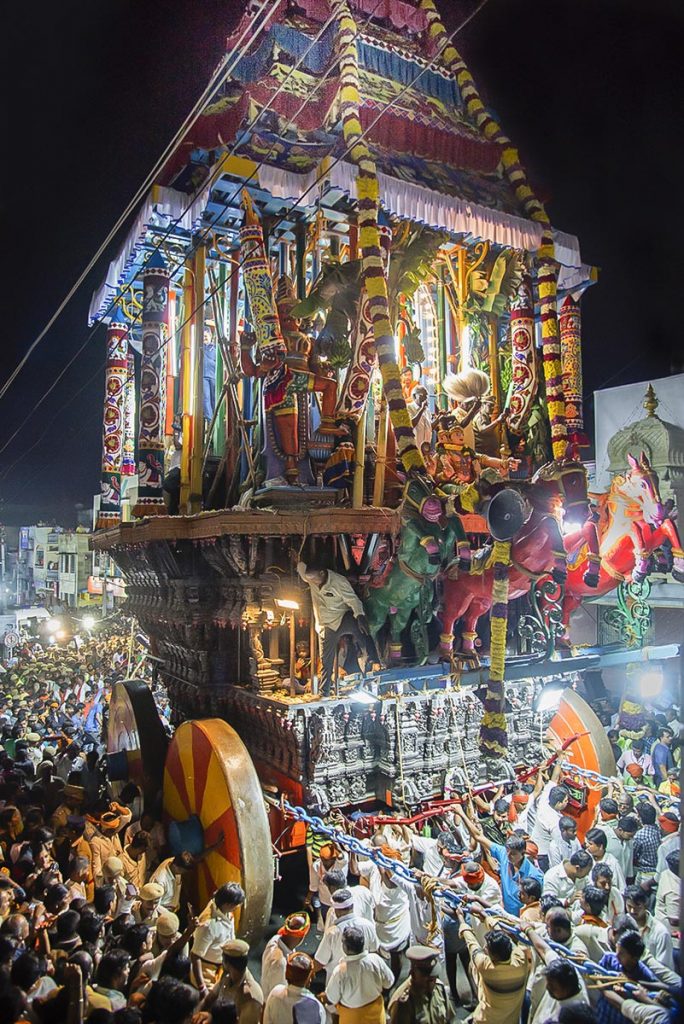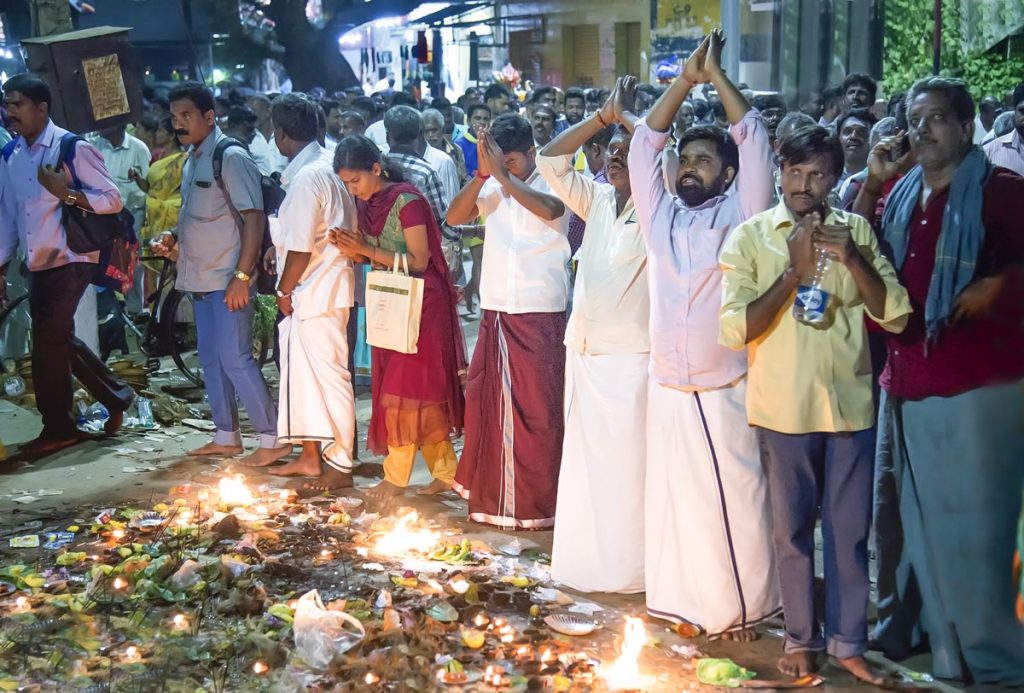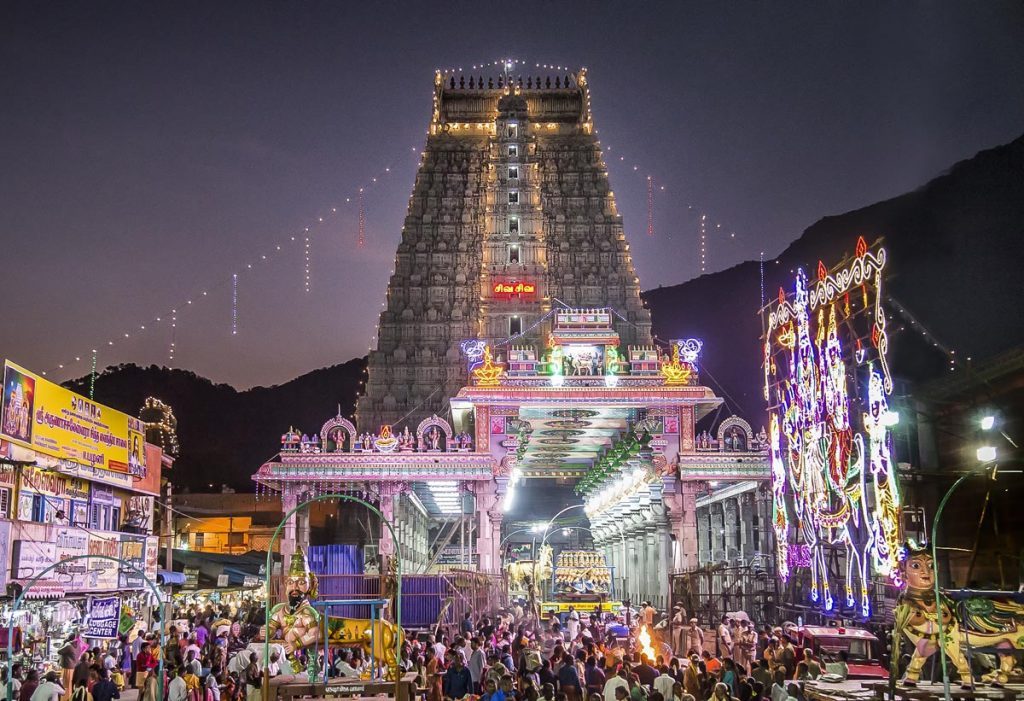My circumambulation of Arunachala mountain in Thiruvannamalai for three years leads me towards ending the circle of birth and rebirth
By Padma Krishnan
On the seventh day of the karthigai deepam festival in 2018, I landed in Thiruvannamalai, or Thiru, as the ancient town is affectionately called by seekers who have made it their home. Thiru means holy in Tamil. I planned to stay three days but ended up living there, on and off, for three years.
The recorded history of the holy town dates back to the ninth century. And the geological history of Arunachala mountain in the middle of town goes back to the Archean age. The mountain is also called Annamalai, Arunagiri, Arunachalam, Arunai, Sonagiri and Sonachalam in various scriptures. It is one of the Pancha Bhuta Sthalas, five elemental Siva temples of Tamil Nadu. Siva is worshiped here as the fire element (see the July/August/September of Hinduism Today online for the origin story). According to the Puranas, the mountain has gone through various transformations through the yugas, which are vast eras. In the Satya Yuga, it was a mountain of fire; in the Treta yuga, it was emerald; in the Dvapara Yuga, it was gold; and in the current Kali yuga, it is a mountain of rocks. These transformations could also be correlated to the change in human consciousness in the cyclical progression of yugas.
Giri is mountain, valam=circumambulation; aruna=red/fire; and achalam=unmovable. While the famous monthly full-moon girivalam around the mountain attracts massive crowds, devotees do girivalam every day. It is said there will always be one person walking around the mountain at any time.
Why Do People Do Girivalam?
Devotees of Siva believe He fulfills the desires of those who circumambulate Arunachala Hill, which is considered to be a form of Siva Himself. Indeed, a mere thought of the mountain will liberate a sincere seeker from the cycle of birth and death. According to legends, the first one to perform the girivalam was Goddess Parvati, who did so to compensate for closing Lord Siva’s eyes playfully and plunging the world into darkness. After Her Arunachala penance, Lord Siva blessed Her, by giving Her His left side and thus becoming Ardhanarishvara, “half-female Lord.”

Since the mountain is worshiped as Siva, walking around the mountain is done in reverence. Sincere seekers follow various rules laid down in Puranas, such as keeping the mind focused on Siva and walking either in silence or chanting holy names and walking with awareness.
The 8.7-mile length of the pilgrim circuit is dotted with eight ancient temples in eight directions, where Gods Indra, Agni, Yama, Niruthi, Varuna, Vayu, Kubera and Isanya worshiped Siva in the form of Arunachala. Devotees visit these temples and the main temple of Annamalaiyar during their walk.
My Many Walks
I did my first girivalam in the morning with a few friends. We started at 5:30 and stayed mostly silent. Two of my companions, from Spain, had been living in Thiru for many years and walked the mountain every day. The trek took us about four hours, stopping partway for a filter coffee break. We did not enter any of the temples but prayed from outside. The next day, I walked alone in silence. I went to each and every temple and meditated in the samadhis of Adimudi Siddhar and Isanya Desikar. Devotees believe many siddhas, illumined beings, live here and circumambulate the mountain in their subtle bodies. Their blessings help pilgrims in their sadhanas, and the fortunate might even encounter them.

After two circumambulations, I would start my regular morning walking exercise around 6am, without intending to do the girivalam as a spiritual practice; but my feet carried me around the mountain on their own volition. This happened many times, and I just went along with the flow.
The inner path that runs close to the hills has been prohibited to the public for the past few years, and one needs permission from the forest department to perform the inner girivalam. Pilgrims walk on the paved walkways and on the tar road that covers the holy circuit nowadays.

Even before the pandemic, I avoided crowded events that have potential for stampedes. During the first month of my stay, I had no intention of going for the famous full-moon girivalam. Then, on one full-moon night, I stepped out with a friend for a short after-dinner walk on the girivalam path. The palpable devotion of hundreds of thousands of pilgrims walking, their roar of “Annamalaiyarku arogara,” the meditative Namah Sivaya chant from the speakers, the sound of bells, conches, songs and prayers, the moon and the hill in the moonlight, the smell of food, oil, people, popcorn, camphor, sambrani incense and holy ash enchanted us, and we decided to walk the whole circuit. We had stepped into another world, a world that ran on devotional fervor and moved in a cosmic rhythm controlled by Annamalaiyar and posed no threat of stampede. It was an unforgettable journey! I reached home by 12:30am, totally energized and in awe. After that, I tried to do the full moon walks every month.
On each full moon, about 200 to 300 thousand of us from all walks of life, states of India and other countries join in one sea of movement. I did the girivalam on a new-moon night once with a friend, and the energy was very different from the full moon. I felt it was an intense inward journey. After that, I regularly walked on new-moon nights also. This is done mainly by sadhaks and is less crowded, except for special amavasya days. Circumambulating the mountain during pradosham is also considered very auspicious and attracts many devotees. I have seen barefooted people breezing around the mountain on the tarred road as if carried by a great power, some struggling with each step and others strolling casually while talking on their phones. I met a woman who does it every day and another man who has done it continuously for four years.

For those who practice intense sadhana in Thiruvannamalai the mountain is their guru; the walk is their guide; and their goal is to merge with the mountain, slipping into its eternity. Whenever I leave Thiru, not knowing when I will return to the magical mountain, I remember the words of a local woman who once walked the path with me: “Annamalaiyar will come with you wherever you go.”

About the Author
Padma Krishnan is an independent journalist living in India. A certified hatha yoga teacher, she is passionate about exploring commonalities in ancient mystical traditions.

A frank and informative article by Padma Krishnan about the Holy Mountain, Thiruvannamalai (TVM) with a personal touch. Enjoyed the easy reading style. My first visit to TVM was in January 1997.
Had the privilege of meeting the author in January 2020 in TVM before my return to London, United Kingdom.
நான் 2013 முதல் அண்ணாமலை கிரிவலம் செல்கிறேன் பழ காரியம் நடைபெற்றது
Prior to my departure for London, England, in January 2020, I had the pleasure of meeting the author in TVM.
Great clicks, simple and easy reading article, can feel the enthusiasm u felt everytime u did the girivalam including the casual first one. Quite inspiring
A sacred read of the Sacred place “Thiru”, very refreshing as you read through the lines. Expressed the ambiance of the girivalam path with a real feel. Thanks to the author for writing it. Worth the read!